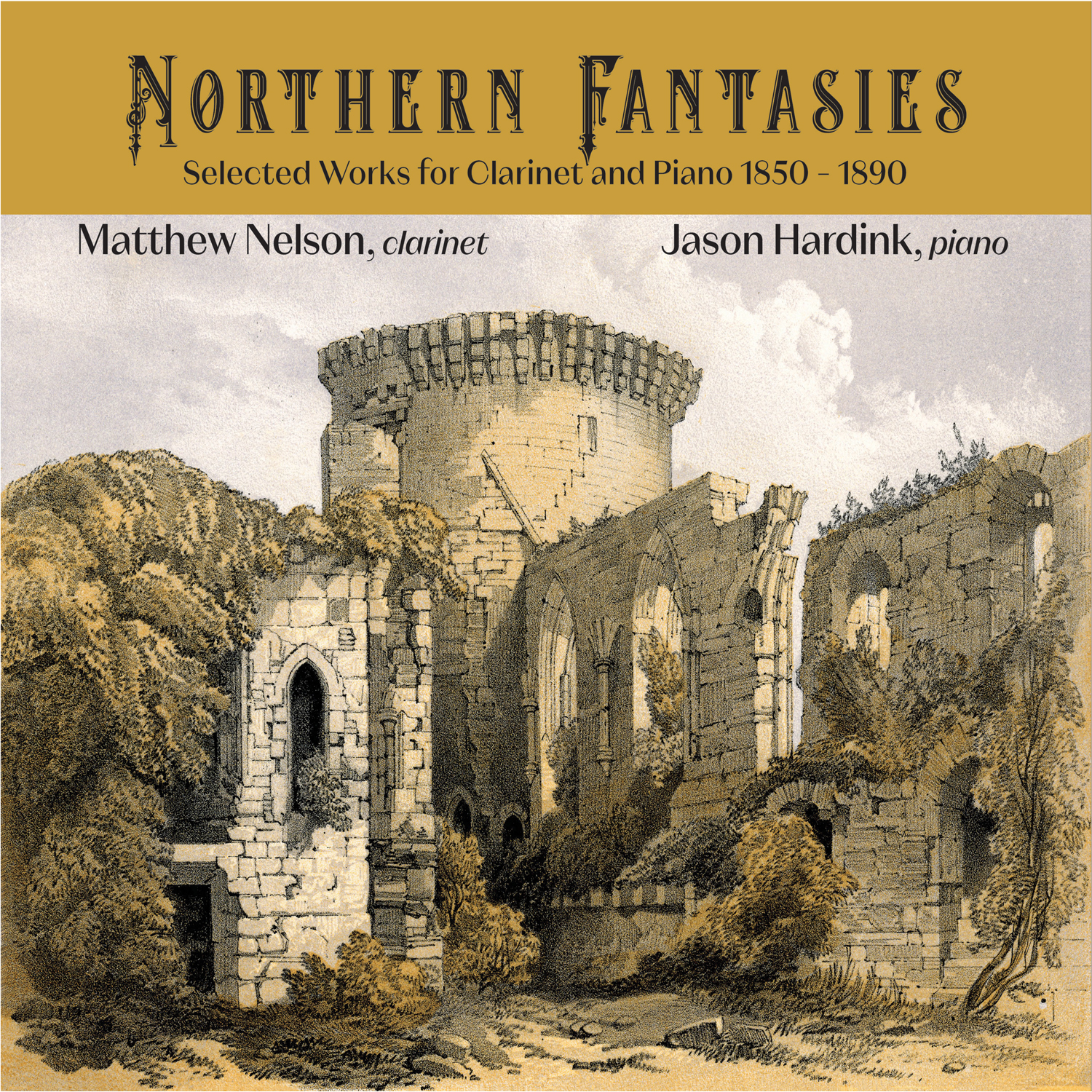Sonata, Op. 38 - Felix Draeseke (1835 - 1913)
Felix Draeseke composed his Sonata, Op. 38 in 1888, six years before Brahms would complete his formidable Op. 120. Known for his early associations with Liszt and Wagner, Draeseke had discarded the relatively free Neudeutsche Schule aesthetic by the time he composed his clarinet sonata. The harmony in Op. 38 preserves a Wagnerian sense of chromaticism, yet Draeseke delineates classical formal schemes and proportion in each of the four movements: a lively sonata form in the first, an Adagio ABA form in the second, a Scherzo/Trio in the third, and a final virtuosic and heroic Allegro con brio. Performers and promoters largely ignored Draeseke’s works throughout the 20th century, though the efforts of the Internationale Draeseke-Gesellschaft have yielded more exposure since the IDG’s inception in 1986.
Drei Phantasiestücke, Op. 19 - August Winding (1835 - 1899)
Danish pianist and composer August Winding enjoyed considerable acclaim during his lifetime, though his name and works were consigned to obscurity for the majority of the past century. A student of the great Romantic composers Niels Gade and Carl Reinecke, Winding taught at the Copenhagen Conservatory from 1867, eventually succeeding Gade as director of the conservatory in 1891. Winding composed symphonies, piano concerti, chamber works, songs, and piano works. He dedicated his orchestral Ouverture til en Sørgespil, Op. 7 to his friend Edvard Grieg, who in an 1872 letter wrote, "I still feel warmly for your ouverture and I have an enormous desire to perform it at the last concert at the Musikforening." Winding’s works also elicited praise from Hugo Riemann, whose encyclopedia (1900) describes him as a "productive and remarkable composer," and Hans von Bülow, who specifically mentions the Drei Phantasiestücke among a number of Winding’s "notable compositions" in his 1882 Skandinavischen Concertreiseskizzen.
Winding composed his Drei Phantasiestücke, Op. 19 in or around 1871 and published the work through Kistner (Leipzig) in 1872 with both clarinet and violin parts. Drei Phantasiestücke was undoubtedly influenced by the burgeoning genre of fantasy pieces for clarinet and piano established by Schumann (1849), Gade (1864), and Reinecke (1865). Though Winding’s harmonic progressions venture beyond the conservatism of his teachers and foreshadow works by later Danish composers, his pieces possess a characteristically clear formal scheme and contrapuntal texture. Winding dedicated the Drei Phantasiestücke to Mozart Petersen, the foremost Danish clarinetist of his day and the dedicatee of Gade’s famous Fantasiestücke, Op. 43. Unfortunately, Petersen passed away within two years of the publication of Winding’s Op. 19, and he likely never performed the work.
Fantasiestücke, Op. 43 - Niels Gade (1817 - 1890)
Written in 1864, Niels Gade’s Fantasiestücke, Op. 43 receives the most modern attention (performances and recordings) of any of the works presented in this program, though by some measures it is also the most conservative. Regarded as the greatest Danish composer of his generation, Gade spent much of his early career in Germany, affording him ample exposure to Schumann and Mendelssohn. Both composers considered him a close friend and championed his work. The compositional language of Gade’s work owes its most direct influence to the traditionalism of Mendelssohn, and yet the "fantasy" genre (into which Op. 43 falls) is a clear nod to Schumann, who made frequent and imaginative use of the form. Op. 43, written for eminent Danish clarinetist Mozart Petersen, contains four contrasting movements: a lyrical Andantino con moto, an impetuous Allegro vivace, a dark and epic Ballade, and an energetic Allegro molto vivace. Like Schumann before him, Gade gives no specific program for these four movements, though their distinct characteristics might imply such.
Schottische Bilder, Op. 112 - Carl Loewe (1796 - 1869)
German composer Carl Loewe wrote his Schottische Bilder, Op. 112 in 1850 for his son-in-law, who was an amateur clarinetist. The work exhibits fascinatingly intricate piano writing typical of Loewe’s well-regarded lieder, and though the clarinet writing is simple, it evokes the vocal spirit of the lied in much the same way as the melodic content in the clarinet part of Schumann’s Op. 73. In his Op. 112, Loewe presents three programmatic movements: "The Lady of the Lake," "The Wanderer at Bothwell Castle," and "The Scottish Clan." These comprise a balanced set, with a fantasia-like opening movement, a flowing second movement, and a final march. This work might have been more frequently performed and recorded but for the fact that it requires a C clarinet--an instrument that has fallen out of standard use.
Matthew Nelson
Felix Draeseke composed his Sonata, Op. 38 in 1888, six years before Brahms would complete his formidable Op. 120. Known for his early associations with Liszt and Wagner, Draeseke had discarded the relatively free Neudeutsche Schule aesthetic by the time he composed his clarinet sonata. The harmony in Op. 38 preserves a Wagnerian sense of chromaticism, yet Draeseke delineates classical formal schemes and proportion in each of the four movements: a lively sonata form in the first, an Adagio ABA form in the second, a Scherzo/Trio in the third, and a final virtuosic and heroic Allegro con brio. Performers and promoters largely ignored Draeseke’s works throughout the 20th century, though the efforts of the Internationale Draeseke-Gesellschaft have yielded more exposure since the IDG’s inception in 1986.
Drei Phantasiestücke, Op. 19 - August Winding (1835 - 1899)
Danish pianist and composer August Winding enjoyed considerable acclaim during his lifetime, though his name and works were consigned to obscurity for the majority of the past century. A student of the great Romantic composers Niels Gade and Carl Reinecke, Winding taught at the Copenhagen Conservatory from 1867, eventually succeeding Gade as director of the conservatory in 1891. Winding composed symphonies, piano concerti, chamber works, songs, and piano works. He dedicated his orchestral Ouverture til en Sørgespil, Op. 7 to his friend Edvard Grieg, who in an 1872 letter wrote, "I still feel warmly for your ouverture and I have an enormous desire to perform it at the last concert at the Musikforening." Winding’s works also elicited praise from Hugo Riemann, whose encyclopedia (1900) describes him as a "productive and remarkable composer," and Hans von Bülow, who specifically mentions the Drei Phantasiestücke among a number of Winding’s "notable compositions" in his 1882 Skandinavischen Concertreiseskizzen.
Winding composed his Drei Phantasiestücke, Op. 19 in or around 1871 and published the work through Kistner (Leipzig) in 1872 with both clarinet and violin parts. Drei Phantasiestücke was undoubtedly influenced by the burgeoning genre of fantasy pieces for clarinet and piano established by Schumann (1849), Gade (1864), and Reinecke (1865). Though Winding’s harmonic progressions venture beyond the conservatism of his teachers and foreshadow works by later Danish composers, his pieces possess a characteristically clear formal scheme and contrapuntal texture. Winding dedicated the Drei Phantasiestücke to Mozart Petersen, the foremost Danish clarinetist of his day and the dedicatee of Gade’s famous Fantasiestücke, Op. 43. Unfortunately, Petersen passed away within two years of the publication of Winding’s Op. 19, and he likely never performed the work.
Fantasiestücke, Op. 43 - Niels Gade (1817 - 1890)
Written in 1864, Niels Gade’s Fantasiestücke, Op. 43 receives the most modern attention (performances and recordings) of any of the works presented in this program, though by some measures it is also the most conservative. Regarded as the greatest Danish composer of his generation, Gade spent much of his early career in Germany, affording him ample exposure to Schumann and Mendelssohn. Both composers considered him a close friend and championed his work. The compositional language of Gade’s work owes its most direct influence to the traditionalism of Mendelssohn, and yet the "fantasy" genre (into which Op. 43 falls) is a clear nod to Schumann, who made frequent and imaginative use of the form. Op. 43, written for eminent Danish clarinetist Mozart Petersen, contains four contrasting movements: a lyrical Andantino con moto, an impetuous Allegro vivace, a dark and epic Ballade, and an energetic Allegro molto vivace. Like Schumann before him, Gade gives no specific program for these four movements, though their distinct characteristics might imply such.
Schottische Bilder, Op. 112 - Carl Loewe (1796 - 1869)
German composer Carl Loewe wrote his Schottische Bilder, Op. 112 in 1850 for his son-in-law, who was an amateur clarinetist. The work exhibits fascinatingly intricate piano writing typical of Loewe’s well-regarded lieder, and though the clarinet writing is simple, it evokes the vocal spirit of the lied in much the same way as the melodic content in the clarinet part of Schumann’s Op. 73. In his Op. 112, Loewe presents three programmatic movements: "The Lady of the Lake," "The Wanderer at Bothwell Castle," and "The Scottish Clan." These comprise a balanced set, with a fantasia-like opening movement, a flowing second movement, and a final march. This work might have been more frequently performed and recorded but for the fact that it requires a C clarinet--an instrument that has fallen out of standard use.
Matthew Nelson



